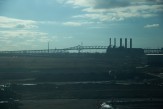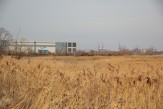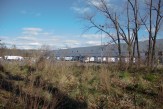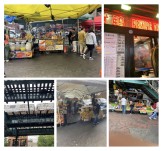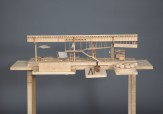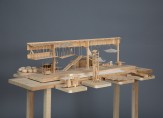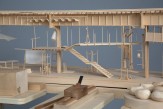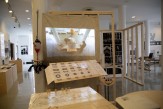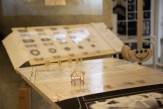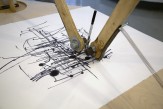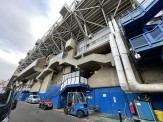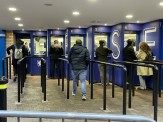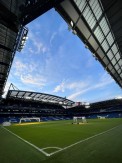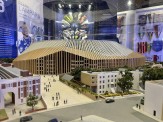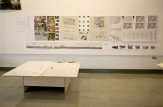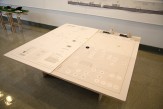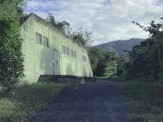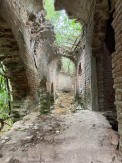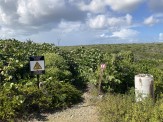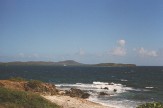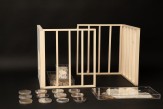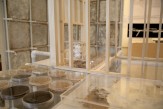2021–2022 Fellowship Recipients
Junmin Chung | Avenel, NJ; Staten Island, NY
Tilok Costa | Roosevelt Ave, Queens, NY
Oleksiy Godz
Kai Huang | London, England
Han Na Kim | US Cities
Maria Eleni Komninou
Sanjana Lahiri | Phoenix, AZ
Harrison Moser | Vieques, Puerto Rico
Ahzin Nam
Projects
-
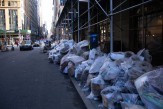
Junmin Chung
-
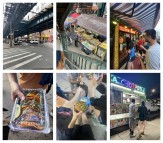
Tilok Costa
-
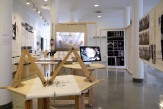
Oleksiy Godz
-
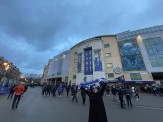
Kai Huang
-

Han Na Kim
-
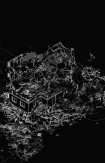
Maria Eleni Komninou
-

Sanjana Lahiri
-
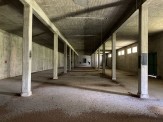
Harrison Moser
-
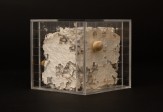
Ahzin Nam
Back
Junmin Chung
According to the Department of Transportation’s 2021 report on truck management, 1.5 million packages were delivered daily in New York City, with 45% of New Yorkers receiving a home delivery at least once a week. By 2045, the city anticipates a 68% increase in demand for packages. The consequences of this rise in demand for e-commerce include congestion and the devaluation of the street as a space for pedestrians. As retailers increasingly move online, the distinction between “front” (commerce) and “back” (services) activities has blurred. Junmin’s thesis reimagined the relationship of the city’s “front” and “back” through a narrative of self-discovery, staged in the interstitial zone within a Midtown Manhattan block. Junmin used his fellowship to visit and document, from the outside, two Amazon fulfillment centers serving New York—one in Avanel, New Jersey, and the other on Gulf Avenue in Staten Island. These visits were instrumental in shaping his thesis.
Tilok Costa
Tilok’s thesis explored street food through its rituals and traditions of serving and consuming, with a specific focus on Roosevelt Avenue, a 5.8-mile corridor in Queens, New York running from Sunnyside to Flushing. While the infrastructure of the 7 train accommodates a diverse spectrum of unique street food cultures, the takeover of these spaces by the standardized, city-regulated design of food carts and the restriction of their movement threatens to neutralize these sites. Tilok’s project proposed an alternative by designing food carts that are specific to the foods they serve, and by redesigning the infrastructure where the carts are sited.
Tilok used his fellowship funding to support site visits to Roosevelt Avenue, where he met with, photographed and sampled food from vendors, and for purchasing materials to build a detailed model, table, stools, and utensils featured in his final thesis presentation.
Oleksiy Godz
For his thesis project—Media for Unlearning Individualism—Oleksiy designed and prototyped a series of objects, tools, machines, and furniture pieces that produce space through collective thinking and decision making, allowing students to unlearn individualism. He used his fellowship support to acquire materials for building, assembling, and testing a desktop, push-pull drawing apparatus made to reimagine drawing as a process of negotiation by two participants. To gain any control and make any marks at all, the participants must coordinate and learn together both how to draw, and how to communicate, verbally and non-verbally.
Kai Huang
Kai’s thesis examined the European football match, its programming, and the way it manages to create temporary enclosure, both culturally and spatially. He began by exploring football culture as a prototype of a new urban system in which form is no longer primarily determined by geometric compositions, axis and grids, but instead by a set of daily, weekly, monthly and annual routines that are eventually spatialized and physically manifested in the built environment. He used his fellowship funding to visit and extensively document football culture and stadiums in London. During his trip he attended a Premier League game and tour at the Stamford Bridge Stadium, toured and digitally mapped the Emirates Stadium and Tottenham Hotspurs Stadium, and visited the Chelsea Football Club Museum.
Han Na Kim
The culture of congestion is no longer unique to Manhattan, but instead a recurring theme in metropolitan areas across the US. According to the INRIX 2020 Traffic Report, New York ranked as the city with the worst traffic in America, followed by the cities like Philadelphia, Boston, and Los Angeles. Han Na’s fellowship funding allowed her visit Boston, Philadelphia, Washington D.C., Houston, Austin, Dallas, San Francisco and Los Angeles to investigate their congestion problems, and how these problems affect people’s everyday life. Han Na selected these cities based on their traffic conditions, urban planning, the presence of technologies companies, and rates of car dependency. She also documented these visits through videos inspired by the prominent architectural artists and filmmakers Beka & Lemoine.
Maria Eleni Komninou
On August 4th, 2020, a port hangar in Beirut, Lebanon caught fire, detonating thousands of tons of ammonium nitrate that had been stored there. The explosion killed at least 218 people and wounded 7,000 others. Following such catastrophic events, which result in massive material displacement and the diffusion of debris clouds across urban environments, it becomes evident that building from debris is unavoidable—a consequence of both growth and destruction. Maria Eleni’s thesis investigated an alternative way of tracing materials by suggesting a post-blast approach to architecture in Beirut. She explored new methods of reconstruction through assemblage and by reconsidering what was lost in relation to preexisting structures. She used her fellowship funding to purchase various elements—including glass, concrete, rebar, resin, wax, and chipboard—for a series a material experiments.
Sanjana Lahiri
The Blue Marble photograph taken by Apollo 17 in 1972 was the first image to encompass the entire planet in one frame. The image presents the earth as both a fragile place requiring our careful stewardship and as an isolated, finite object that can be known, and therefore conquered, in its entirety. This tension informs Gilles Clément’s provocation of the Planetary Garden—the idea that the earth is a garden, and we are its gardeners.
Sanjana’s fellowship funding supported her visit to Clement’s La Vallée garden in Creuse, France, which he has been tending and cultivating for the last fifty years. La Vallée is a site of experimentation, where Clément has activated his theories of the Planetary Garden, the Garden in Movement, and the Third Landscape, and it was also one of the sites Sanjana chose for her thesis intervention.
Harrison Moser
Beginning in the early 1940s, the island of Vieques in Puerto Rico served as the most extensive training area for the United States Atlantic Fleet Forces. The Navy purchased twenty-six thousand acres, about three-quarters of the island, for $1.6 million in 1941 and ran extensive live ammunition training for over sixty years. More than 300,000 munitions were fired during these operations, including ship-to-shore gunfire, air-to-ground bombing, and marine artillery fire. For decades inhabitants put up with loud explosions, massive warships anchored just off the island's coast, and the accumulation of toxic pollutants that are now found in the island's water, plant, and animal life. After prolonged battles in Congress and tenacious objections from the Armed Forces, it was announced in 2001 that the Navy would leave Vieques in May of 2003 and transfer management of the land formerly used for military exercises to the Department of the Interior. Two years after the Navy left, the area was designated a federal Superfund site, and the Environmental Protection Agency mandated a cleanup. Harrison used his fellowship funding to visit Vieques, where he documented the means and methods of "returning" the island’s wasteland to wilderness.
Ahzin Nam
For her thesis, Ahzin developed a method for using living oyster mushroom mycelia to sequester toxic lead ions from surfaces contaminated by lead paint. She allocated half of her funding to purchase petri dishes and observation boxes that she used to cultivate mycelium and microbes, helping her understand patterns of fungal growth. She used the second half of her funding to fabricate full-scale, 1:1 stud wall prototypes to implement what she learned from her cultivation experiments and to test her method of mycoremediation. Support from the fellowship afforded her the freedom to fail while learning how to work with new media and different life forms at the boundary of the natural world and our built environment.

